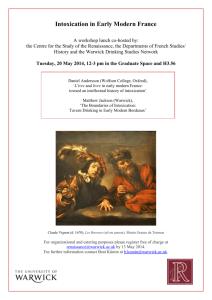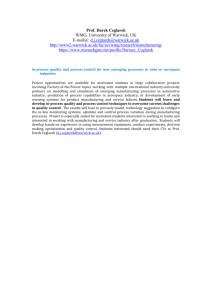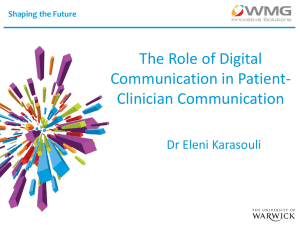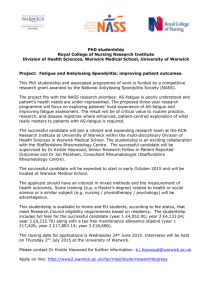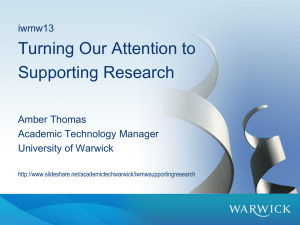Back to Front - University of Warwick
advertisement
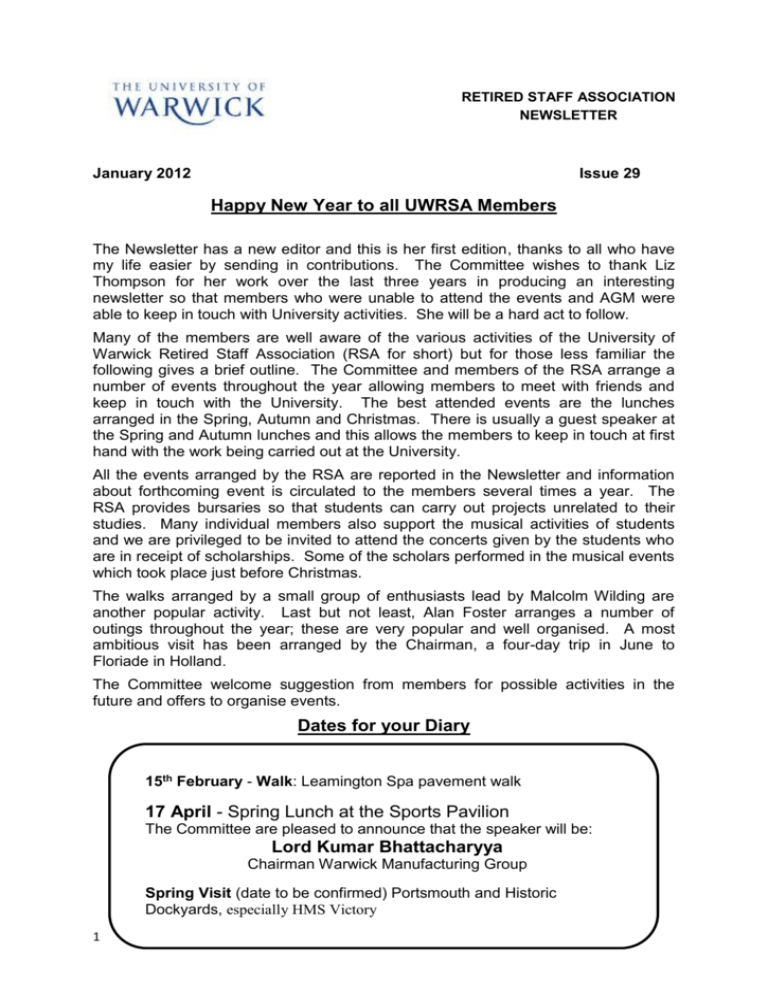
RETIRED STAFF ASSOCIATION NEWSLETTER January 2012 Issue 29 Happy New Year to all UWRSA Members The Newsletter has a new editor and this is her first edition, thanks to all who have my life easier by sending in contributions. The Committee wishes to thank Liz Thompson for her work over the last three years in producing an interesting newsletter so that members who were unable to attend the events and AGM were able to keep in touch with University activities. She will be a hard act to follow. Many of the members are well aware of the various activities of the University of Warwick Retired Staff Association (RSA for short) but for those less familiar the following gives a brief outline. The Committee and members of the RSA arrange a number of events throughout the year allowing members to meet with friends and keep in touch with the University. The best attended events are the lunches arranged in the Spring, Autumn and Christmas. There is usually a guest speaker at the Spring and Autumn lunches and this allows the members to keep in touch at first hand with the work being carried out at the University. All the events arranged by the RSA are reported in the Newsletter and information about forthcoming event is circulated to the members several times a year. The RSA provides bursaries so that students can carry out projects unrelated to their studies. Many individual members also support the musical activities of students and we are privileged to be invited to attend the concerts given by the students who are in receipt of scholarships. Some of the scholars performed in the musical events which took place just before Christmas. The walks arranged by a small group of enthusiasts lead by Malcolm Wilding are another popular activity. Last but not least, Alan Foster arranges a number of outings throughout the year; these are very popular and well organised. A most ambitious visit has been arranged by the Chairman, a four-day trip in June to Floriade in Holland. The Committee welcome suggestion from members for possible activities in the future and offers to organise events. Dates for your Diary 15th February - Walk: Leamington Spa pavement walk 17 April - Spring Lunch at the Sports Pavilion The Committee are pleased to announce that the speaker will be: Lord Kumar Bhattacharyya Chairman Warwick Manufacturing Group Spring Visit (date to be confirmed) Portsmouth and Historic Dockyards, especially HMS Victory 1 AGM and talk, 21 September 2011 Sixty six members attended the AGM and were informed by the Chairman of the work carried out by the Association during the year and planned future events. Other members of the committee also gave brief reports. It was agreed that the new format of the AGM was an improvement and increased efficiency. After a hearty Buffet lunch the attendees settled down to a presentation by the Vice Chancellor, Professor Nigel Thrift. Professor Thrift started by reflecting on what he said to the RSA in 2007. The topic of conversation at that time was the nascent University strategy, Vision 2015, and the consultation process taken to develop it. In retrospect what struck him was the level of engagement of the Warwick community in the development of a vision for the University. Although much had changed since March 2007 and we were now in a markedly different environment he did not intend the speech to be full of doom and gloom. The University strategy of 2007 has become embedded in the day to day life of the University. Since Vision 2015 was launched Warwick has continued to develop an incredibly strong profile. The commitment to excellence is unstinting, aided in no small part by the exponential growth in research income which has increased from about £57 million in 2006/2007, to a record of just over £86 million in the past year. The postgraduate research numbers have seen year on year growth and the University is well on its way to doubling its numbers by 2015. On the back of an excellent result in the RAE 2008, in which Warwick ranked 7th in the country, it is building up to an improved REF (Research Excellence Framework) performance in 2014/15. The Institute of Advanced Study is now fully embedded in the University structure and has raised the international profile significantly, with its new Junior Research Fellowship scheme attracting applications of the highest quality from all over the world. The quality of Warwick undergraduate students is also remarkable. It was particularly pleasing to be ranked as seventh in a list of eight universities that take in the very highest percentage of students with the highest A-level results, also known as England’s Ivy League. Warwick’s international profile has become a rich mix of world class scholarship and research, as well as a commitment to the outside world. In the past few years Warwick has developed a number of initiatives. IGGY, the International Gateway to Gifted Youth, an international network for young people aged between the ages of 11-19 is firmly established and hugely popular. Warwick in Africa sends well over 100 students per year to Ghana, Tanzania, South Africa and Botswana to teach Maths and English, and has recently gained accreditation from the Clinton Global Initiative. Warwick has had two very successful Warwick Commissions, which dealt with the topics of international trade and international finance and gained international media attention. Plans for a third Commission are in place. In the past three years, the web of relationships with core partners across the world has strengthened further. Chief among these are Boston University in the US, and Monash University in Australia. There are numerous research collaborations happening including a major Boston-Warwick conference in the autumn. Following on from an Expression of Interest in setting up an Applied Sciences facility in New York City, a full bid with a consortium that includes a number of eminent international partners is in place. 2 In the past three years the financial sustainability of the University has been the most important part of Warwick’s armour. Professor Thrift recalled that during the consultation process, he noted (almost prophetically) that financial sustainability was going from being a ‘supportive goal’ to a ‘core goal’. As a result, the University has become a more effective generator of income. The annual turnover has risen from just over £310 million in 2006, to an estimated £420 million in the past year, with a surplus of about £20 million. This result has been achieved by Warwick’s historic ability to keep government income low, and self-generated income high. Warwick receives about 23 per cent of its income from government the remainder coming from research grants and contracts, commercial activities, and student fees. Success in securing philanthropic income has improved and there are plans to increase this significantly. The campaign, 50 Forward, to raise £50 million in development income by 2015 was launched earlier in the year and £24 million has already been raised. The historically close relationship with industry continues to thrive. Earlier this year, WMG opened an Advanced Technology Centre with Jaguar Land Rover, bringing 170 JLR employees on to campus. Through the partnership with Cisco five telepresence suites have opened on campus, giving Warwick world-class video conferencing facilities. The partnership with GE Healthcare allows academics in the Medical School, WMG, and the local university hospital to link into GE’s global campaign to use research, education and strategic partnerships to deliver improved healthcare. Professor Thrift was sure RSA members would have followed the debates - and protests - about the increase in tuition fees and be aware that Warwick has decided, after extensive consultations, to set fees at the top rate of £9000. Partly this was to do with the cuts in public sector funding – a decrease of about 70% in the teaching budget in the coming academic year. The decision to charge £9000 is not without other consequences; most obviously the expectations the government has about the expanded role that universities should play in widening participation and opening up access to a broader, more representative student cohort. Warwick can already hold its head high in terms of widening participation and access, but there is more that can be done. Warwick’s access agreement was signed off by the Office for Fair Access earlier in the summer. The University aimed for a balance of ambition and realism in setting the targets – ensuring the Access Agreement reflected a feasible blueprint for how to go about widening participation. Packages of fee waivers and bursaries worth up to £4500 for students from the lowest income households have been developed. Outreach work in schools flourishes in parts of the University and will continue across the whole campus. What Next? The future is uncertain and the University faces many daunting tasks. One is the size and shape of the University. Recent government announcements have declared a freeing up of constraints on home student numbers for students with the highest A-Level tariff. As a result of this decision, a serious discussion about the future size and shape of the University is underway especially as somewhere in the region of 82 per cent of Warwick students are in that high-achieving bracket. Second, and related, is the ‘student experience’, a catch all term for the broader experience students have when they come to Warwick, such as how they develop in other ways – career planning, internships, languages, volunteering, overseas experience – all essential components of the preparation for life that students increasingly expect from a degree. Shortly all students will have the opportunity to 3 undertake diplomas in areas like languages or entrepreneurship. Ways to increase contact time with academics, and to enable students to get the most out of their interactions with top faculty members are being investigated. Third, is what might be called the institutional status of the University. In this world of contradictions and frustrations, Warwick has started to discuss the possibility of notfor-profit private ownership and to explore what some form of employee ownership might mean for the University. Fourth, and related to all of the above, is the international dimension. What will be key to the success of any internationally minded university is the ability to develop research capacity away from home. Warwick will shortly be signing a new agreement with Monash University enabling it to enter into a more serious and comprehensive collaborative relationship which will be quite unique in global higher education. Finally, there is the campus which Professor Thrift hoped the audience would agree was an increasingly pleasant and impressive place to live, work and in which to socialise. In the time since he last spoke to the RSA there had been numerous developments: Digilab has been completed; WBS has expanded; the Students’ Union has undergone a huge renovation, as has the Butterworth Hall in the Arts Centre. Student residences have expanded again, with a new 520 room building nearing completion and another one in construction on Lakeside, and the Material and Analytical Sciences building and Centre for Mechanochemical Biology almost complete. Environmental sustainability is still very high on the list of priorities and informs the decision-making about expansion, including a 50% reduction of carbon emissions by 2020. In addition, work on a cycle path to Kenilworth is underway. Concluding, Professor Thrift said it had been a challenging four years but on balance the highs had outweighed the lows. He thanked the RSA for the opportunity to speak and for maintaining such an active interest in the University. The members enthusiasm demonstrated a commitment that clearly lived on beyond their time at the University. He hoped they continued to inspire such commitment in retiring Warwick staff. After answering questions from the floor the Professor was thanked for a stimulating speech and he continued to answer questions as the group dispersed. Summary by Liz Prichard ************ Walk at Leek Wootton Wednesday 13 July 2011 Back to Front It served me right really, if I’d have realised that I would be leading the walk I would have paid more attention. And so it came to be that on Wednesday, 13 th July, in Leek Wootton I led a ‘back to front’ walk. I’d done the walk with my husband, Les. He’d written out instructions just in case he wouldn’t be around to prompt my memory. As it turned out he was working in Tanzania so I took the aforementioned instructions plus a small map and set off into darkest Warwickshire. But it wasn’t dark, it was glorious sunshine and everyone was in high spirits as we selected a gate to exit the churchyard adjacent to The Anchor public house. Unfortunately it was the wrong gate, (there were three to choose from) 4 and by the time I’d realised my mistake the group were in fine fettle and voted for adventure rather than turning back. We set off down a grassy slope and headed towards Leek Wootton golf course where several men, all sporting red polo shirts, were teeing off. Circling the golf course we were treated to glimpses of players, mature trees and a large, attractive, house. We then worked our way across a series of fields planted up with crops and others left fallow. The sun shone as we meandered through a patch of woodland where rays penetrated the dense foliage casting patterns on the parched earth. Jackets and coats were removed as we re-emerged into the light and crossed another field before re-entering a wood. Along the route were several boggy pools which, no doubt, mature into ponds after a bout of rain. The stile free walk was popular with the trampers as we passed hedgerows and yet more fields of crops on our way back to the golf course. We passed a couple of dog walkers as I read backwards up from the bottom of my crib sheet and Malcolm checked that we were on the right road. Indeed we were. As Leek Wootton Police Headquarters hove into view I knew that we were near the end of our adventure and that a welcome cool drink would be waiting in The Anchor. The headquarters is housed in a beautiful old mansion framed by neat grounds. A quick march up the side of the course and alongside some allotments brought us back to where we had started. I wouldn’t recommend following instructions upside down or indeed back to front, but all was well that ended well. Kay Rainsley Walk from Lapworth, Monday 1 August 2011 The week prior to our walk on the 1st August the weather had been unusually hot so I felt a little worried when it drizzled on the way to the Navigation Inn at Lapworth where the walk was to begin. However, it stopped as the twenty six walkers began to arrive and after ordering our lunch, we set off for the five and a half mile walk. We began on the tow path of the canal alongside the Navigation Inn, it was good to see the occasional barge making its way along the canal and the residential bargees with their tables and chairs set out in their small garden plots. 5 After a short road walk we crossed into the leafy Packwood House Millennium Walkway, stopping at the House for a group photo, followed by a short walk through Packwood Copse, which has been modified to be used by the young scouting community for country adventures. After a short road walk we joined up again with the canal tow path this time passing by the locks and watched with interest a barge navigating its way through, apparently one of 22 in two days. And seeing barges turn around in the middle of the canal with such precision, only put off by a group of walkers waiting for something exciting to happen! We grouped again at the beautiful Kingswood Junction where the Grand Union and the Stratford-uponAvon Canals merge and where many barges are docked, it's a lovely spot to sit and watch it all going on. We walked the final short stretch of canal with lovely hedgerow and flowering bushes, before arriving at the pub for a much needed drink and refreshment. To make it more enjoyable the sun came out before we finished the walk. I enjoyed putting the walk together and the several times I walked it prior to this day but it was far more enjoyable this final time with friends, so thank you all for coming. June Clarke Report on Charlcote Visit, Thursday 18 August 2011 A Rainy Day – for once After what seemed like weeks of continuous blue skies, a dire weather forecast appeared the previous night on the BBC. For one day only, rain was expected, perhaps welcomed by the farmers and gardeners but not by the RSA. Nevertheless, a party of 29 members plus a couple of grandchildren gathered at the car park in a light drizzle, and following a bit of admin., we walked down to the house to be met by our guide Janet. Entering the west park, the drizzle turned into a steady downpour, and umbrellas were deployed. We heard about an old village which had long since been deserted as the previous owners of the house had diverted the road to consolidate the parkland, and a history of the house and the Lucy family. A herd of deer was also quite obligingly near. We were able to view the house from an unusual viewpoint, and after an hour or so, the orangery restaurant was very welcome for lunch. 6 Following lunch, a number of members toured the house, and enjoyed a talk on Elizabethan costume. A special effort had also been made by the volunteer cooks in the Victorian kitchen where typical food of that era was being prepared for us to sample. Altogether, a most interesting and enjoyable day, and our thanks are due to the volunteers who turned out to talk to us. Malcolm & Carolyn Wilding Walk from Burton Green, Monday 26th September 2011 Seventeen members and friends gathered in the car park of the Peeping Tom at around 10 a.m. on a cloudless sunny day, with a few puddles by the road as a reminder of the overnight showers. Having ordered our lunches we crossed the road and took a footpath to the south, encountering an inquisitive but friendly horse, and then swinging round over fields with golden-brown cattle to cross the planned path of HS2 and then join the trackbed of the old Kenilworth - Balsall Common railway line. After walking this for several hundred yards towards Kenilworth we turned south on a road and then on paths to follow a loop that brought us back to the old trackbed at the same point where we had left it. We now walked away from Kenilworth until we picked up a footpath that took us back past the cattle and the horse to the pub and our lunches. Many of us chose to have the good-value carvery lunch. Had a time-traveller from a hundred years ago joined us on the walk, they would have noted the houses along Cromwell Lane as new, and probably would have been surprised at the loss of hedgerows dividing many of the fields and the absence of track on the railway trackbed, but otherwise would have found the countryside little changed. Chris Hall Walk on Thursday 20th , October 2011 The Phantom Coach, at the junction of Charter Avenue and the A45, is not an obvious place to start a walk, but the member who originally intended to lead an October walk was injured, and there was little time to research an alternative. The replacement leader designed a route that was on local paths already familiar to him. After a short walk along the A45 we proceeded along fields and pathways to the university site, entering at Tocil Wood. Then along by the lake to Gibbet Hill Road which we crossed to take a courtesy path at the bottom of the playing fields and thence to Cryfield Grange Road. Walking for about half a mile along this road 7 brought us to the path by Roughknowles Wood, where we turned back towards Coventry. At the bottom of the slope we went along a bridle path alongside Whitefield Coppice, and then through a gap in the hedge to re-enter the university site. Our route brought us past the vice-Chancellor’s house, and then down the sports pavilion road to Gibbet Hill Road, and across to walk between the old (whitetile) student residences and the (just-opened) Bluebell residences. The path by the (other) lake brought us out onto the road near Tesco, and thence back to the pub. Some members were surprised at the amount of recent development at the university. There were also comments on how it had been possible to walk through a largely built-up area walking almost all the time on paths or fields. Had this walk been undertaken at the start of the last century the pub, Charter Avenue and the A45 would not have existed, and the largest settlement we would have been near would have been at Canley Hall at the end of Shultern Lane with its two associated farms and their buildings and cottages in the Cannocks Lane/Ivy Farm Lane area. Chris Hall Walk around Catherine de Barnes, Wednesday, November 23rd , 2011 Was it the promise of a flat walk with no stiles on minor roads of paths and only four miles long that tempted the twenty walkers who turned out on this fine morning? Or was it a sense of curiosity to discover where and what Catherine de Barnes was? Whatever the reason it was really good to see so many familiar faces and a number of new ones out with us for the first time. After a short introduction pointing out that Catherine de Barnes was not a romantic heiress or abandoned mistress but in fact a distortion of the name of some no doubt ghastly Norman, we set off in perfect conditions. Half way round the walk we ran into a number of strange puns on the term whale watching’ and eventually came to their source – the Whale tanker factory. Their obvious commitment to improving the environment (a lake, a vast number of newly planted trees and 70,000 daffodils promised for the spring) was inspiring as was their commitment to the well-being of their workforce. After a short but exhilarating stretch right next to the M42 we crossed the second ford of the walk next to an old water mill and then returned to the deep peace of the Grand Union Canal. Once back at the Boat Inn we were made very welcome and enjoyed an excellent and very sociable lunch. Godfrey Carr ************* Visit to York, Wednesday 9 November 2011 Once we had cleared the local traffic congestion our journey was uneventful, arriving at York mid-morning. The use of the local toilets in the coach park caused some concern as the charge had increased from 20p to 40p per visit. However, we soon dispersed and headed for the nearest gate to enter the city. Here we were able to enjoy the delights that York has to offer. It was like entering a living museum, ancient timbre buildings, narrow winding streets such as the Shambles, and High and Low Petergate linked crooked squares where street entertainers performed. 8 Obviously, The Minster proved popular together with the numerous museums. In particular the National Railway Museum was very attractive especially with a newly restored CORANATION CLASS engine and tender on display. A visit to “Betty’s”, the famous tea rooms was a must for most members for a welcome coffee or lunch. However, with Christmas shopping and visits completed we departed from York late afternoon. Our next Spring Visit will probably be to Portsmouth and the Historic Dockyards, especially HMS Victory. Alan Foster ************ WURSA Bursaries 2011-12 This year 19 applications were received for the total of £1000 available for Bursaries. The projects were of a high standard and it was agreed that three applications were worthy of support, the amount awarded being a contribution to the expenses of the project. The presentations of the awards were made by the RSA Committee at University House on 30 November, 2011. £500 to Carrie Hurst (3rd year MBChB student) to document photographically, for exhibition, her experiences in observing clinical practices in two very different healthcare settings in Borneo (city and rainforest village). Carrie is a trained and prizewinning photographer and has been involved with WAMS (Widening Access to Medical School), a group that organises school visits and workshops in the locality as part of a widening access programme. The bursary will help meet the expenses of organising her exhibition of photographs on her return from Borneo. £250 to David James Coates (2nd year part-time PhD student, School of Theatre and Performance) to bring the intriguing histories of private theatricals back to life, with particular reference to Chatsworth House which has a documented record of the presentation of such performances including the retention of original scenery. The theatricals will be staged professionally before a paying audience and has the support of the Head Curator of the National Trust. The events will receive wide publicity and will offer the opportunity for an increased involvement of the University Department with the National Trust. 9 £250 to Miranda Mylne and Thomas de Burgh (Warwick Medical School) to document photographically, and thus create, an up-to-date picture of nomadic life in the Middle East (‘Empty Quarter’ of Oman) at a time when such a culture is under many pressures. The foci of study will be the nomad economy, health systems and traditions, subsistence and social organisation. Miranda has gained degrees in Art and Design, and Pharmacology before coming to Warwick, and has exhibited in photographic competitions; she was raised in Oman. Tom also has photographic experience and he is currently an officer in RAMC as well as being a graduate medical student at Warwick. They plan a photographic exhibition and to write an article for National Geographic Magazine. Terry Kemp ************ Christmas lunch Tuesday 13 December, 2011, Scarman House A record number of 121 attended the Christmas lunch in Scarman house. As usual the meal was excellent although some items ran out before everyone had been served. However, everyone enjoyed the convivial atmosphere and there was ample opportunity to catch up with old friends and chat to new members and their guests in the lounge area where coffee and mince pies were served. This was very good start to the festive season. ************* WURSA Membership At the end of 2011 the membership of the RSA was 260, during the year 12 new members joined and there were 6 resignations and 6 who did not renew their membership. Sadly 3 of our members died during the latter part of the year. In spite of effort from the Committee and the members, staff are retiring from the University unaware of the existence of the Retired Staff Association. I would like to thank the 150 Members who have already renewed their subscriptions for 2012. For those who put it aside for dealing with later but cannot now lay their 10 hands on the form, just contact me and I will send you another by post or by email. Closing date for renewals is 31 March 2012. Maybe we can all make an Olympic effort to get the membership up to 300 in 2012. Membership of the Association keeps you in touch with the University and gives you many concessions; use of the Library, reduced membership fees for sporting activities, discount in the Book shop and invitations to many social events throughout the year. Currently for use of the Swimming Pool and/or playing Racket Games the annual charge for Members is £49 and for each nominated family member the charge is £65. If in addition to these facilities you wish to use the Fitness Centre, the annual charge is £175 per Member or £198 for each family member. For those who already have membership of the Sporting facilities please note that the renewal date for this may not be January (it depends on the date your subscription started). For those wishing to join please contact Esther Zaccarelli (Personnel Services, telephone 024 7657 4467). Bill Prichard COMMITTEE 2011/2012 CONTACT DETAILS Chair Secretary Treasurer Membership Secretary Walks Co-ordinator Visits Co-ordinator Committee members Newsletter Editor Human Resources support 11 Steve Van Toller Jean Norman Colin Brummitt Bill Prichard svanto@ntlworld.com norman467@btinternet.com goddardmail@googlemail.com william.prichard@btinternet.com Malcolm Wilding Alan Foster Joan Cole Georgie Hale Pat Scott Terry Kemp Liz Prichard Suzanne Keene malcolmdwilding-rsa@yahoo.co.uk joan_and_alan@yahoo.co.uk colejoanm@aol.com georgina.hale@tiscali.co.uk jimscott1@btinternet.com terry-sheila@ntlworld.com elizabeth.prichard@btinternet.com suzanne.keene@warwick.ac.uk
